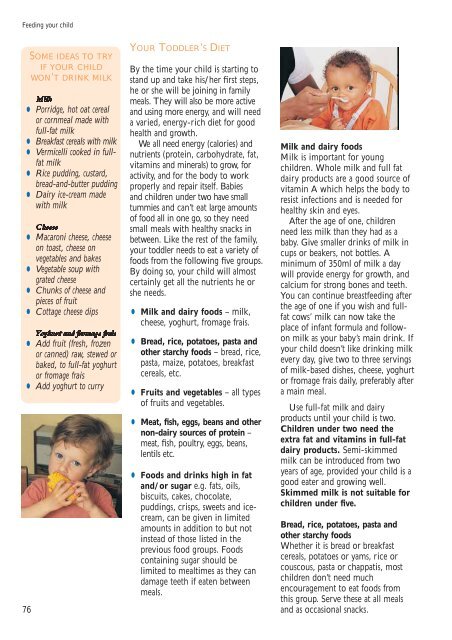Here - Health Promotion Agency
Here - Health Promotion Agency
Here - Health Promotion Agency
Create successful ePaper yourself
Turn your PDF publications into a flip-book with our unique Google optimized e-Paper software.
Feeding your child<br />
SOME IDEAS TO TRY<br />
IF YOUR CHILD<br />
WON’T DRINK MILK<br />
Milk<br />
•<br />
Porridge, hot oat cereal<br />
or cornmeal made with<br />
full-fat milk<br />
Breakfast cereals with milk<br />
• Vermicelli cooked in fullfat<br />
milk<br />
• Rice pudding, custard,<br />
bread-and-butter pudding<br />
•<br />
Dairy ice-cream made<br />
with milk<br />
Cheese<br />
•<br />
Macaroni cheese, cheese<br />
on toast, cheese on<br />
vegetables and bakes<br />
• Vegetable soup with<br />
grated cheese<br />
•<br />
pieces of fruit<br />
• Cottage cheese dips<br />
Chunks of cheese and<br />
Yoghurt and fromage frais<br />
•<br />
Add fruit (fresh, frozen<br />
or canned) raw, stewed or<br />
baked, to full-fat yoghurt<br />
or fromage frais<br />
Milk<br />
• Add yoghurt to curry<br />
76<br />
YOUR TODDLER’S DIET<br />
By the time your child is starting to<br />
stand up and take his/her first steps,<br />
he or she will be joining in family<br />
meals. They will also be more active<br />
and using more energy, and will need<br />
a varied, energy-rich diet for good<br />
health and growth.<br />
We all need energy (calories) and<br />
nutrients (protein, carbohydrate, fat,<br />
vitamins and minerals) to grow, for<br />
activity, and for the body to work<br />
properly and repair itself. Babies<br />
and children under two have small<br />
tummies and can’t eat large amounts<br />
of food all in one go, so they need<br />
small meals with healthy snacks in<br />
between. Like the rest of the family,<br />
your toddler needs to eat a variety of<br />
foods from the following five groups.<br />
By doing so, your child will almost<br />
certainly get all the nutrients he or<br />
she needs.<br />
•<br />
Milk and dairy foods – milk,<br />
cheese, yoghurt, fromage frais.<br />
•<br />
Bread, rice, potatoes, pasta and<br />
other starchy foods – bread, rice,<br />
pasta, maize, potatoes, breakfast<br />
cereals, etc.<br />
•<br />
Fruits and vegetables – all types<br />
of fruits and vegetables.<br />
•<br />
Meat, fish, eggs, beans and other<br />
non-dairy sources of protein –<br />
meat, fish, poultry, eggs, beans,<br />
lentils etc.<br />
•<br />
Foods and drinks high in fat<br />
and/or sugar e.g. fats, oils,<br />
biscuits, cakes, chocolate,<br />
puddings, crisps, sweets and icecream,<br />
can be given in limited<br />
amounts in addition to but not<br />
instead of those listed in the<br />
previous food groups. Foods<br />
containing sugar should be<br />
limited to mealtimes as they can<br />
damage teeth if eaten between<br />
meals.<br />
and dairy foods<br />
Milk is important for young<br />
children. Whole milk and full fat<br />
dairy products are a good source of<br />
vitamin A which helps the body to<br />
resist infections and is needed for<br />
healthy skin and eyes.<br />
After the age of one, children<br />
need less milk than they had as a<br />
baby. Give smaller drinks of milk in<br />
cups or beakers, not bottles. A<br />
minimum of 350ml of milk a day<br />
will provide energy for growth, and<br />
calcium for strong bones and teeth.<br />
You can continue breastfeeding after<br />
the age of one if you wish and fullfat<br />
cows’ milk can now take the<br />
place of infant formula and followon<br />
milk as your baby’s main drink. If<br />
your child doesn’t like drinking milk<br />
every day, give two to three servings<br />
of milk-based dishes, cheese, yoghurt<br />
or fromage frais daily, preferably after<br />
a main meal.<br />
Use full-fat milk and dairy<br />
products until your child is two.<br />
Children under two need the<br />
extra fat and vitamins in full-fat<br />
dairy products. Semi-skimmed<br />
milk can be introduced from two<br />
years of age, provided your child is a<br />
good eater and growing well.<br />
Skimmed milk is not suitable for<br />
children under five.<br />
Bread, rice, potatoes, pasta and<br />
other starchy foods<br />
Whether it is bread or breakfast<br />
cereals, potatoes or yams, rice or<br />
couscous, pasta or chappatis, most<br />
children don’t need much<br />
encouragement to eat foods from<br />
this group. Serve these at all meals<br />
and as occasional snacks.

















